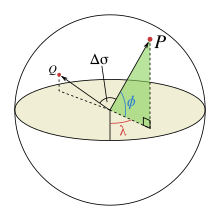C# JackLib系列之如何获取地球上两经纬度坐标点间的距离
获取地球上两经纬度坐标点间的距离,利用【大圆距离公式】
A diagram illustrating great-circle distance (drawn in red) between two points on a sphere, P and Q. Two antipodal points, u and v, are also depicted.
谷歌都在用呢, C#实现的代码如下:
/// <summary>
/// 地球半径
/// </summary>
private const double EARTH_RADIUS = 6378.137;
/// <summary> /// 获取两点之间的距离,大圆距离公式 /// </summary> /// <param name="lat1"></param> /// <param name="lon1"></param> /// <param name="lat2"></param> /// <param name="lon2"></param> /// <returns></returns> public static double DistanceOfEarthTwoPoints(double latA, double lngA, double latB, double lngB) {
double radLat1 = lat1 * Math.PI / 180.0;
double radLat2 = lat2 * Math.PI / 180.0;
double a = radLat1 - radLat2;
double b = lon1 * Math.PI / 180.0 - lon2 * Math.PI / 180.0;
double s = 2 * Math.Asin(Math.Sqrt(Math.Pow(Math.Sin(a / 2), 2) + Math.Cos(radLat1) * Math.Cos(radLat2) * Math.Pow(Math.Sin(b / 2), 2)));
s = s * EARTH_RADIUS;
s = Math.Round(s * 1000000) / 1000000;
return s; }
当然还有另一种写法:
/// <summary> /// 获取两点之间的距离,大圆距离公式 /// </summary> /// <param name="lat1"></param> /// <param name="lon1"></param> /// <param name="lat2"></param> /// <param name="lon2"></param> /// <returns></returns> public static double DistanceOfEarthTwoPoints(double latA, double lngA, double latB, double lngB) { double s = Math.Acos(Math.Cos(Rad(latA)) * Math.Cos(Rad(latB)) * (Math.Cos(Rad(lngA) - Rad(lngB))) + Math.Sin(Rad(latA)) * Math.Sin(Rad(latB))); s = s * EARTH_RADIUS; s = Math.Round(s * 1000000) / 1000000; return s; }
其实这两个方法是完全等价的,只是化简程序不同而已,看看下面的解释:
Formulas
Let  and
and  be the geographical latitude and longitude of two points 1 and 2, and
be the geographical latitude and longitude of two points 1 and 2, and  their absolute differences; then
their absolute differences; then  , the central angle between them, is given by the spherical law of cosines:
, the central angle between them, is given by the spherical law of cosines:
The distance d, i.e. the arc length, for a sphere of radius r and  given in radians
given in radians
Computational formulas
On computer systems with low floating-point precision, the spherical law of cosines formula can have large rounding errors if the distance is small (if the two points are a kilometer apart on the surface of the Earth, the cosine of the central angle comes out 0.99999999). For modern 64-bit floating-point numbers, the spherical law of cosines formula, given above, does not have serious rounding errors for distances larger than a few meters on the surface of the Earth.[2] The haversine formula is numerically better-conditioned for small distances:[3]
Historically, the use of this formula was simplified by the availability of tables for the haversine function: hav(θ) = sin2(θ/2).
Although this formula is accurate for most distances on a sphere, it too suffers from rounding errors for the special (and somewhat unusual) case of antipodal points (on opposite ends of the sphere). A more complicated formula that is accurate for all distances is the following special case of the Vincenty formula for an ellipsoid with equal major and minor axes:[4]
When programming a computer, one should use the atan2() function rather than the ordinary arctangent function (atan()), so that  is placed in the correct quadrant.
is placed in the correct quadrant.
The determination of the great-circle distance is just part of the more general problem of great-circle navigation, which also computes the azimuths at the end points and intermediate way-points.
posted on 2016-05-05 09:31 shaozhuyong 阅读(665) 评论(0) 收藏 举报







 浙公网安备 33010602011771号
浙公网安备 33010602011771号